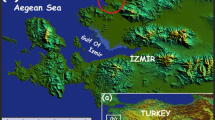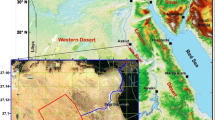Abstract
The microzonation map of any region is important to plan proper design of building, especially in seismic prone region. This paper discusses the use of remote sensing data and digital elevation model (DEM) in evaluating the site-specific conditions for microzonation map of Syria. We have made efforts to quantify the dynamic properties of surface soil for Syrian territory in terms of shear velocity \(V_{\text{S}}^{30}\) and predominant period \(T_{S_0}^{30}\) and have prepared a microzonation map that divides the surface soil into various classes according to Syrian building code. In the present study, we have used ASTER satellite DEM of high resolution (30 × 30 m pixel size) to produce slope map of the Syrian territory. The slope-velocity \(V_{\text{S}}^{30}\) model is used to generate the base velocity map. The map of predominant period is also created. We present microzonation maps with respect to dynamic properties of soil (\(V_{\text{S}}^{30}\), \(T_{S_0}^{30}\)) that show four classes. The used slope-velocity model failed to characterize the sites which have velocities lower or higher than the assigned range bounds. The present results show that the value of \(V_{\text{S}}^{30}\) varies in the range 180–760 m/s and fits the geological, tectonic, geomorphological and topographic settings of Syria. The results indicate that the predominant period of surface soil varies in the range of 0.1578–0.667 s. A quick review on general amplification factor “F” is presented which varies in the range 1.381–5.83 for Syrian territory \(\left( {\bar{F} = 3.66} \right)\). The produced site-class characterization maps are very much required by Syrian anti-seismic design code.



















Similar content being viewed by others
References
Abdallah I, Malkawi H, Liang R, Jamal H, Al-Homoud N, Al-Homoud A (1995) Probabilistic seismic hazard zonation of Syria. Nat Hazards 12–2:139–151. doi:10.1007/BF00613073
Ahmad AR (2004) Geological setting and dynamic properties of soils in Tartous area (Syria). National Academy of Sciences of Armenia, Reports 104-No. 4:295–302
Ahmad AR (2005) Seismic conditions of soil and building’s dynamic properties in Tartous city (Syria). Ph.D. thesis, Yerevan State University of Architecture and Construction
Ahmad AR (2013) Seismic hazard assessment of Syria. J Seismol Earthq Eng (JSEE) 15–1:1–13
Ahmad AR, Khachian EY (2006) A new method for calculating the dominant periods of multilayer of soil. Hayки o Зeмлe (Armenia) LIX—1: 41–50
Ahmad AR, Singh PR (2002) Comparison of various data fusion for surface features extraction using IRS-PAN LISS-III data. Adv Space Res 29–1:73–78
Ahmad AR, Zeizafoon S, Khalil A, and Hammoud A (2013) Syrian seismicity analysis using catalog data of the year 1365 BC until the year 2013. Internal report, Syrian National Earthquake. 1–10
Aki KI (1991) Characterization and mapping of earthquake shaking for seismic zonation. Fourth international conference on seismic zonation, Stanford, California
Alchalbi A et al (2009) Crustal deformation in northwestern Arabia from GPS measurements in Syria: slow slip rate along the northern Dead Sea fault. Geophy J Int. doi:10.1111/j.1365-246X.2009.04431.x
Al-Khoubi I, Stephen H, John A (2000) Probabilistic seismic hazard maps for Syria. National Earthquake Hazards Program (EAST), Geological Survey of Canada
Allen TI, Wald DJ (2007). Topographic slope as a proxy for seismic site-conditions (V 30S ) and amplification around the globe. US Geol Surv Open-File Report 69:1357
Allen TI, Wald DJ (2009) On the use of high-resolution topographic data as a proxy for seismic site conditions (V 30S ). Bull Seism Soc Am 99(2A):935–943
Al-Maleh K, Mouty M, Brew G, Barazangi M, Bach-Imam I (2001) Mesozoic stratigraphy and geologic development of Syria. GeoArabia 6:573–616
Al-Saad DT, Sawaf T, Gebran A, Barazangi M, Best J, Chaimov T (1992) Crustal structure of central Syria: the intracontinental Palmyride mountain belt. Tectonophysics 207:345–358
Alsdorf D, Barazangi M, Litak R, Seber D, Sawaf T, Al-Saad D (1995) The intraplate Euphrates depression-Palmyrides mountain belt junction and relationship to Arabian plate boundary tectonics. Ann Di Geofisica 38:385–397
Anderson JG, Lee Y, Zeng Y, Day S (1996) Control of strong motion by the upper 30 meters. Bull Seism Soc Am 86:1749–1759
Barazangi M, Seber D, Chaimov T, Best J, Litak R, Al-Saad D, Sawaf T (1993) Tectonic evolution of the northern Arabian plate in western Syria. In: Boschi E, Mantovani E, Morelli A (eds) Recent evolution and seismicity of the Mediterranean region. NATO ASI Series. Kluwer Academic Publishers, The Netherlands, pp 117–140
Best JA, Barazangi M, Al-Saad D, Sawaf T, Gebran A (1993) Continental margin evolution of the northern Arabian platform in Syria. Am As Pet Geol Bull 77:173–193
Boore DM, Joyner WB, Fumal TE (1993) Estimation of response spectra and peak accelerations from western north american earthquakes: an interim report. US Geological Survey Open-File Report:93-509, pp 1–72
Boore DM, Joyner WB, Fumal TE (1997) Equations for estimating horizontal response spectra and peak accelerations from Western North American earthquakes: a summary of recent work. Seism Res Lett 68:128–153
Borcherdt RD (1970) Effects of local geology on ground motion near San Francisco Bay. Bull Seismol Soc Am 60:29–61
Borcherdt RD (1994a) Estimates of site-dependent response spectra for design (methodology and justification). Earthq Spectra 10:617–653
Borcherdt RD (1994b) An integrated methodology for estimates of site-dependent response spectra, seismic coefficients for site dependent building code provisions, and predictive GIS maps of strong ground shaking. Proc Semin Appl Technol Counc ATC 35–1:101–1044
Bouchon M, Barker JS (1996) Seismic response of a hill: the example of Tarzana, California. Bull Seismol Soc Am 86(1A):66–72
Bozorgnia Y, Niazi M (1993) Distance scaling of vertical and horizontal response spectra of the 1989 Loma Prieta earthquake. Earthq Eng Struct Dyn 22:695–707
Brew EG (2001) Tectonic evolution of Syria interpreted from integrated geophysical and geological analysis. Ph.D. thesis, Cornell University, USA, p 138
Brew G, Lupa J, Barazangi M, Sawaf T, Al-Imam A, Zaza T (2001a) Structure and tectonic development of the Dead Sea fault system and Ghab basin in Syria. J Geol Soc Lond 158:665–674
Brew G, Sawaf T, Al-Maleh K, Barazangi M (2001b) Tectonic and geologic evaluation of Syria. GeoArabia 6(4):573–615
Campbell KW (1981) Near-source attenuation of peak horizontal acceleration. Bull Seism Soc Am 71–6:2039–2070
Campbell KW (1991) An empirical analysis of peak horizontal acceleration for the Loma prieta, California earthquake of October 18 1989. Bull Seismol Soc Am 81–5:1838–1858
Castro RR, Mucciarelli M, Pacor F, Petrungaro C (1997) S-wave site-response estimates using horizontal-to-vertical spectral ratios. Bull Seism Soc Am 87:256–260
Chaimov T, Barazangi M, Al-Saad D, Sawaf T (1993) Seismic fabric and 3-D upper crustal structure of the southwestern intracontinental Palmyride fold belt, Syria. Am As of Pet Geol Bull 77:2032–2047
Chiou BSJ, Youngs RR (2006) PEER-NGA empirical ground motion model for the average horizontal component of peak acceleration and pseudo-spectral acceleration for spectral periods of 0.01–10 seconds. Interim Report for USGS Review:219 http:// peer.berkeley.edu/lifelines/repngamodels.html
David J, Wald DJ, Allen TI (2007) Topographic slope as a proxy for seismic site conditions and amplification. Bull Seism Soc Am 97–5:1379–1395
Devyatkin EV, Dodonov AE, Sharkov EV, Zykin VS, Simakova AN, Khatib K, Nseir H (1997) The El-Ghab rift depression in Syria: its structure, stratigraphy, and history of development. Stratigr Geol Correl 5:362–374
Domas J (1994) The late Cenozoic of the Al Ghab Rift, NW Syria. Sborn’ik geologick’ych ved Antropozoikum 21:57–73
El Hariri A (1991) Seismotectonic Study, Seismic Hazard Assessment and Zonation of the Arab Republic of Syria. M.Sc. Thesis, Institute of Earthquake Engineering and Engineering Seismology, Skopje
Fäh D, Rüttener E, Noack Th, Kruspan P (1997) Microzonation of the city of Basel. J Seismol 1:87–102
Field EH, Jacob K (1993) Monte Carlo simulation of the theoretical site response variability at Turkey flat, California, given the uncertainty in the geotechnically derived input parameters. Earthq Spectra 9–4:669–702
Fukushima Y, Tanaka (1981) A new attenuation for peak ground acceleration, velocity and displacement based on multiple regression analysis of Japanese strong motions. Bull Seism Soc Am 71:757–783
García D, Singh SK, Herráiz M, Ordaz M, Pacheco DJ (2005) Inslab earthquakes of central Mexico: motion parameters and response spectra. Bull Seismol Soc Am 95:2272–2282
Gomez F, Meghraoui M, Darkal AN, Tabet C, Khawlie M, Khair K, Sbeinati R, Charabe M, Darawcheh R, Barazangi M (2000) Coseismic displacements along the Serghaya fault: an active branch of the Dead Sea fault system in Syria and Lebanon. J Geol Soc Lond 158–3:405–408. doi:10.1144/jgs.158.3.405
Hatem ME, Hussam EZ, Dojcinovski D, Mihailov V (2012) Re-evaluations of seismic hazard of Syria. Int J Geosci Sci Res 3:847–855
Holzer TL, Padovani AC, Bennett MJ, Noce TE, Tinsley JC (2005) Mapping V 30S site classes. Earthq Spectra 21:353–370
Joyner WB, Fumal TE (1985) Predictive mapping of earthquake ground motion. Eval Earthq Hazards Los Angel Reg. US Geol Surv Profess 1360:203–220
Lermo J, Chavez-Garcia FJ (1993) Site effect evaluation using spectral ratios with only one station. Bull Seism Soc Am 83:1574–1594
Matsuoka M, Wakamatsu K, Fujimoto K, Midorikawa S (2005) Nationwide site amplification zoning using GIS-based Japan engineering geomorphologic classification map. In: Proceedings of the 9th international conference on structural safety and reliability. 239–246
McClusky S, Balassanian S (2000) GPS constraints on plate kinematics and dynamics in the eastern Mediterranean and Caucasus. J Geophys Res 105:5695–5719
Mohraz B (1976) A study of earthquake response spectra for different geological conditions. Bull Seism Soc Am 66:915–935
Park S, Elrick S (1998) Predictions of shear-wave velocities in southern California using surface geology. Bull Seism Soc Am 88:677–685
Ponikarov et al (1964) Geological map of Syria. The general establishment of geology and mineral resources, Damascus, Syria
Résonance, Rovina, Tissières (1999) Mikrozonierung der Region Visp. Zwischenbericht, CREALP
Schnabel B, et al (1972) SHAKE—a computer program for earthquake response analysis of horizontally layered sites. EERC: 72–12
Seed HB, Ugas C, Lysmer J (1976) Site-dependent spectra for earthquake-resistant design. Bull Seism Soc Am 66:221–243
Singh PA (2015) Seismic hazard evaluation in Anjar city area of western India: microtremor array measurement. Soil Dyn Earthq Eng 71:143–150
Singh PR, Aman A, Prasad YJ (1996) Attenuation relations for strong ground motion in the Himalayan region. Pure appl Geophys 147–1:161–180
Singh PA, Annam N, Kumar S (2014) Assessment of predominant frequencies using ambient vibration in the Kachchh region of western India: implications for earthquake hazards. Nat Hazards 73–3:1291–1309. doi:10.1007/s11069-014-1135-2
Sobaih M, Badawi S, Ahmad K (1994) Probabilistic estimates of the seismic ground motion hazard in Syria. The first Cairo earthquake symposium, Cairo, ESEE
Stromeyer D, Grünthal G (2009) Attenuation relationship of macroseismic intensities in Central Europe. Bull Seismol Soc Am 99:554–565
Tuladhar R, Cuong NNH, Yamazaki F (2004) Seismic microzonation of Hanoi, Vietnam using microtremor observations. 13th world conference on earthquake engineering Vancouver, B.C., Canada, Paper No. 2539
Wald DJ, Allen TI (2007) Topographic slope as a proxy for seismic site conditions and amplification. Bull Seismol Soc Am 97:1379–1395
Wills CJ, Petersen MD, Bryant WA, Reichle MS, Saucedo GJ, Tan SS, Taylor GC, Treiman JA (2000) A site-conditions map for California based on geology and shear wave velocity. Bull Seism Soc Am 90:S187–S208
Yamazaki F, Ansary MA (1997) Horizontal-to-vertical spectrum ratio of earthquake ground motion for site characterization. Earthq Eng Struct Dyn 26:671–689
Yousef N (2014) Dynamic properties of soil and it’s response under seismic forces in Al-rraqa City. MSc. Thesis, Higher Institute of Earthquake Researches and studies, Damascus University, Damascus, Syria
Zaineh H, Yamanaka H, Dakkak R, Khalil A, Daoud M (2012) Estimation of shallow s-wave velocity structure in damascus city, Syria, using microtremor exploration. Soil Dyn Earthq Eng 39:88–99
Zaineh H, Yamanaka Y, Dhakal P, Dakkak R, Daoud M (2013) Strong ground motion simulation during the November 1759 earthquake along Serghaya fault in the metropolitan of Damascus, Syria. J Seismol 17:1295–1319
Acknowledgments
The author would like to express his gratitude to Prof. Ramesh P. Singh, Chapman University, Orange, California, USA, anonymous referees and the Editor for their fruitful and valuable comments which have helped me to improve earlier version of the manuscript. The author is grateful to the Japanese ATSER satellite website for making DEM and terrain images available.
Author information
Authors and Affiliations
Corresponding author
Rights and permissions
About this article
Cite this article
Ahmad, R.A. Seismic microzonation map of Syria using topographic slope and characteristics of surface soil. Nat Hazards 80, 1323–1347 (2016). https://doi.org/10.1007/s11069-015-2025-y
Received:
Accepted:
Published:
Issue Date:
DOI: https://doi.org/10.1007/s11069-015-2025-y




